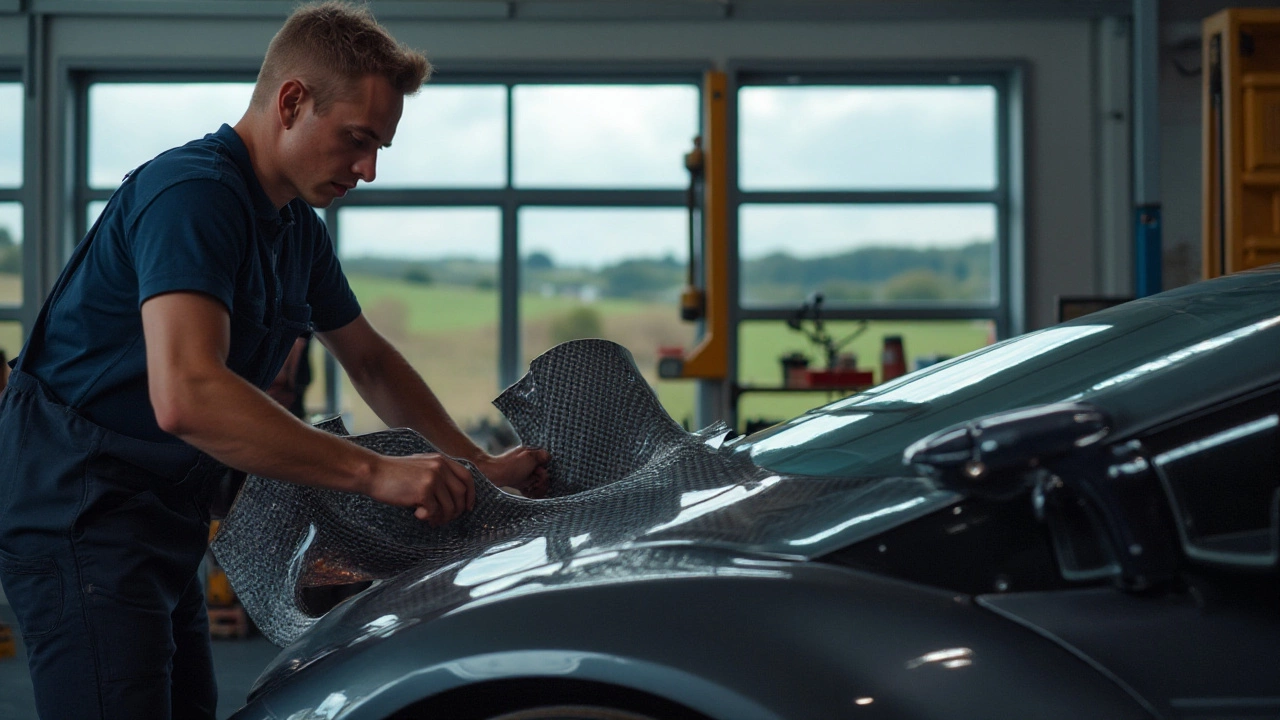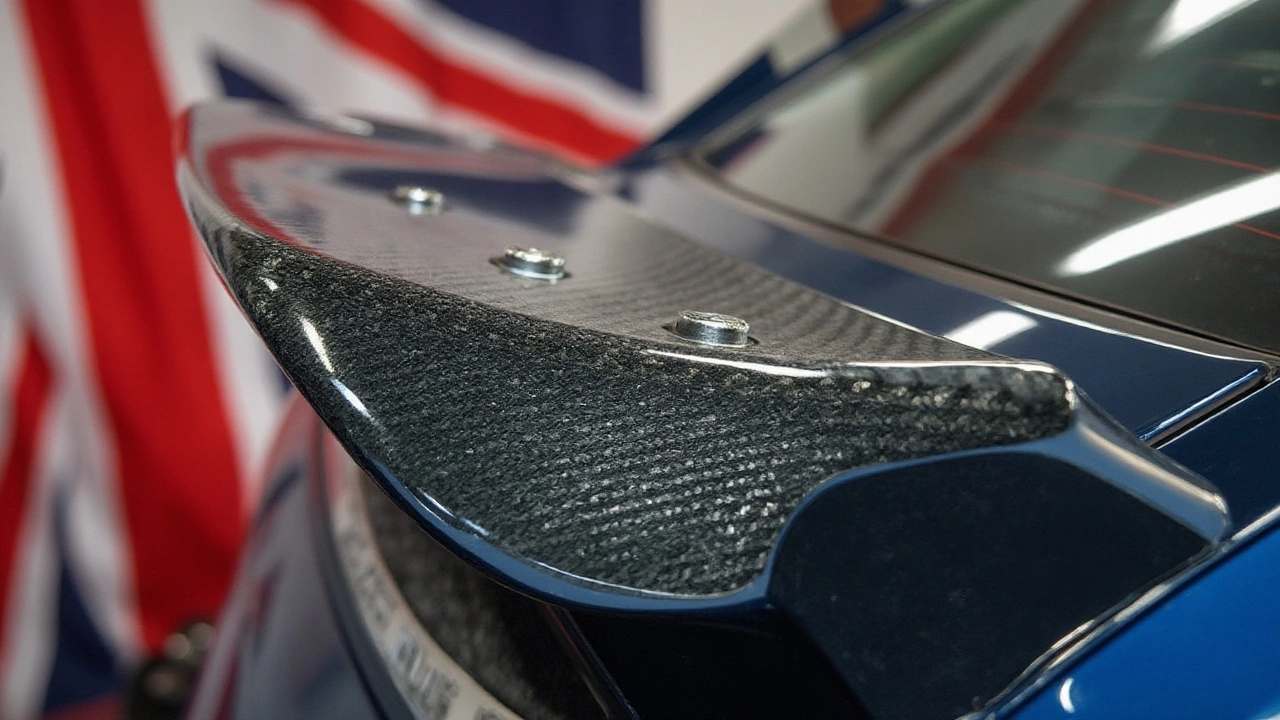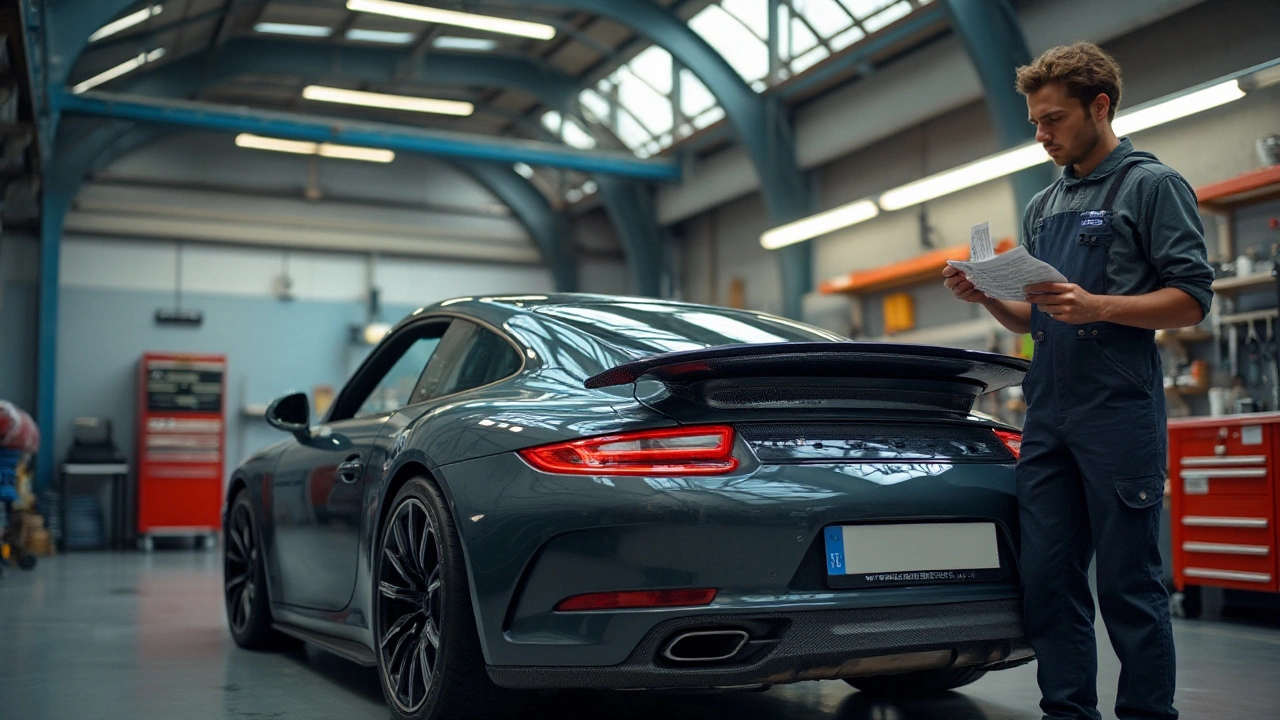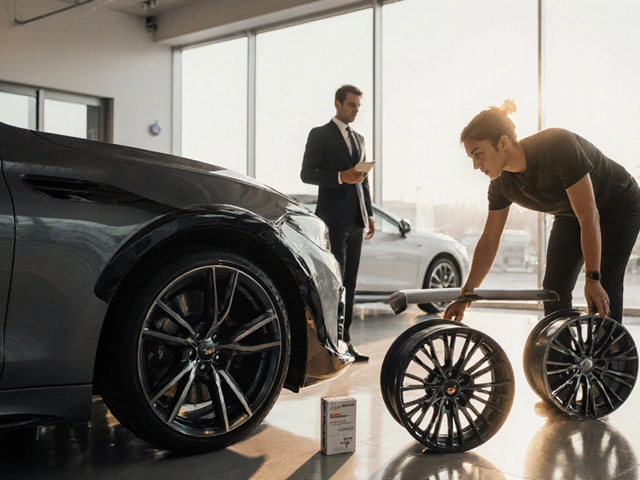Installing a carbon fiber spoiler might seem daunting at first, especially for those who have never ventured into car modifications before. Many hobbyists and enthusiasts take pride in seeing their vehicle transform with new aesthetics and functions. But is it something you can tackle on your own?
This article will guide you through the process, shedding light on what you need to know before you embark on this journey. We'll explore both the excitement and challenges involved, ensuring you're armed with essential tips and knowledge to make the installation smooth and rewarding. Ready to boost both your car's look and its aerodynamic prowess? Let's dive in!
- Understanding Spoilers and Their Benefits
- Preparation Before Installation
- Step-by-Step Installation Guide
- Troubleshooting Common Issues
- Tips for Maintaining Your Spoiler
Understanding Spoilers and Their Benefits
Carbon fiber spoilers have become a staple among car enthusiasts looking to enhance the visual appeal and aerodynamic efficiency of their vehicles. Spoilers are those sleek attachments placed on the rear end of cars, primarily designed to disrupt undesired air movement. By doing so, they improve a vehicle's stability by reducing lift, which in turn increases traction—a vital factor when you're cruising at high speeds on an open highway or zipping through a tight racetrack. But spoilers aren't just all about fancy looks and high-performance benefits. They've got a bit of a scientific charm, too. Introducing spoilers into your vehicular repertoire showcases not just style but a love for functional engineering.
Practical Benefits of Installing Spoilers
When it comes to the practical benefits, spoilers do much more than simply looking good. Let's talk performance. For everyday drivers, spoilers can contribute to better fuel efficiency, often serving as an eye-catching method of boosting your ride's aerodynamic profile and making fuel consumption more efficient by reducing drag. True, the differences might be more noticeable at higher speeds, but any improvement counts when fuel costs are high. And if you think these are just claims, think otherwise! Many studies, including tests conducted by top car manufacturers, have time and again demonstrated the tangible advantages of spoilers on aerodynamics, effectively enhancing the driving experience.
According to an industry expert interviewed by Auto Express, "A well-fitted spoiler, especially of high-quality material like carbon fiber, can make a significant difference in terms of both aesthetics and performance,"—a testament to its dual role in styling and functionality.
Designers and engineers spend significant effort in crafting the perfect shape, angle, and material for these components. A well-designed spoiler isn't just thrust onto your car's rear. Instead, it's integrated into the vehicle's design ethos from the start, meant to deliver peak performance while looking stunning. As such, the choice of materials like carbon fiber isn't by accident—it's intentional. This substance is incredibly light yet incredibly strong, giving manufacturers the leeway to mold creative and effective designs without adding excessive weight to the vehicle.
Styles and Variations of Spoilers
The marketplace for car modifications caters to an incredible array of spoiler styles. Some of the popular variations include lip spoilers, pedestal spoilers, and wing spoilers, each adding a unique flair. Lip spoilers are subtle yet elegant, offering an understated way of improving your car's look without shouting for attention. Pedestal spoilers, often spotted on sports cars, strike a balance between aesthetics and substantial aerodynamic improvements. Wing spoilers, considerably big, may look extravagant to some but serve serious aerodynamic functions, making them a favorite among racers. Each style allows you to personalize your vehicle, reflecting either a racing persona, a luxurious flair, or an understated elegance, all while maintaining the core benefits of improved fuel efficiency and stability.
Preparation Before Installation
Before you get into installing that sleek new carbon fiber spoiler, it's vital to spend some time preparing. Diving in without proper preparation can lead to issues that might tarnish your car's aesthetics and potentially affect its performance. One crucial step is collecting all necessary tools and materials. A suitable installation typically demands a set of basic tools like a ratchet set, a drill with appropriate bits, and likely some adhesive if holes are not your preferred method. Additionally, do not underestimate the power of proper measurements. Ensuring everything lines up perfectly before drilling or adhering is crucial for that snug fit.
Another key factor is your working area. Make sure you have a clean, spacious area to work in. A tidy workspace prevents misplaced parts and reduces the likelihood of any accidental damage. Having a bright light can help spot any surface imperfections on the installation site of the car. Surface preparation of your vehicle is also essential. Cleaning the area where the spoiler will be mounted ensures adhesion and prevents dirt from compromising the bond strength.
"Preparation is the key to any successful installation. By setting the groundwork, you avoid problems later on," says auto expert and enthusiast Alex Carter.
Evaluating your readiness is another crucial step. Don’t underestimate the time a spoiler installation can take. A DIY install can be the perfect Saturday project, but it's best approached with a patience mindset – the same you’d use assembling a complex puzzle or tackling an intricate model car. Allowing yourself ample time reduces stress and errors, making for a smoother process. Keep safety in mind by wearing protective gear such as goggles and gloves, especially when dealing with tools and chemicals.
Lastly, consider consulting your vehicle’s owner manual or manufacturer's guidelines. These documents often provide specific instructions or precautions that are particular to your car model, saving you headaches later on. Friends or online forums can also be valuable resources, as many enthusiasts have shared experiences or tips that might be germane to your exact project. Gathering guidance and ammo is as essential as the physical tools you'll use. By carefully laying the groundwork, you're more likely to achieve that factory-finished look that transforms your car into a head-turner.

Step-by-Step Installation Guide
Installing a carbon fiber spoiler can be a thrilling project for any car enthusiast looking to enhance their vehicle. It's crucial to approach this task methodically to ensure a perfect fit and functionality. Before diving into the actual installation, gather all the necessary tools which typically include a drill, screwdriver set, measuring tape, masking tape, and some weather-resistant adhesive sealant. Don’t forget to read the manufacturer's instructions specific to your spoiler model as this can save you time and headaches.
Step 1: Preparation and Alignment
Before you begin drilling, it's important to ensure proper alignment. Place the carbon fiber spoiler on your car's trunk lid to visualize how it will look once installed. Use masking tape to mark the ideal placement. Be meticulous with measurements to make sure the spoiler is centered. Many find it useful to step back a few feet and assess the symmetry from multiple angles.
Step 2: Drilling Holes
Once you've finalized the position, it's time to drill. Mark the locations for the holes using a pencil or a marker. Double-check these marks and ensure they align with the pre-drilled holes on your spoiler. With a steady hand, drill into the marked spots. Remember that being cautious at this stage can prevent any unintended damage to your vehicle. As Michael Shelby, an experienced automotive expert, once said:
"Measure twice, drill once. Precision is key, and it’s always better to be safe than sorry."
Step 3: Securing the Spoiler
After drilling, remove any metal shavings or debris. Carefully align the carbon fiber spoiler back onto the trunk, matching the drilled holes. Use bolts and screws provided in your spoiler kit to fasten it securely. Ensure each bolt is tightened evenly to avoid pressure points. For those looking to go the extra mile, applying a thin bead of weather-resistant adhesive sealant around the bolt holes can help prevent any water ingress.
Step 4: Final Adjustments and Inspection
Once the spoiler is in place and secured, take a moment to admire your work. Check the alignment once more to make sure everything looks streamlined. Jiggle the spoiler slightly to ensure it’s firmly attached—there should be no movement or rattling. This might be an excellent time to take your car for a short drive to experience the new aerodynamic advantage firsthand. Motor industry studies suggest that well-installed spoilers can improve downforce at speeds above 60 mph by as much as 10%. Such enhancements not only look great but also add functional benefits.
Troubleshooting Common Issues
When tackling the installation of carbon fiber spoilers, even the most prepared DIY enthusiast can encounter a hiccup or two along the way. One of the common problems many face is misalignment. This usually happens when the spoiler is not properly aligned with the car's existing contours. To avoid this, ensure that you're measuring from fixed points on the vehicle—even a half-inch difference can be quite visible. Take multiple measurements and mark them clearly before drilling any holes.
Another frustration often comes from improper drilling, leading to uneven holes or damage to the car's surface. It's essential to use well-maintained tools and select the right drill bit size. If the holes are misaligned, it might be necessary to use a larger diameter bolt with washers to secure the spoiler installation. Always practice on spare materials first, which helps you find your rhythm and confidence before working on your prized vehicle.
Sometimes, after installation, you may notice vibrations or noise at high speeds. This is often due to loose fittings or inadequate bonding of adhesive materials. To combat this, double-check all fasteners and use high-quality adhesive specifically designed for automotive use. A practical tip is to use silicone sealant on the edges of the spoiler to suppress any rattling and ensure a firm fit. Some enthusiasts suggest checking periodically, especially after long drives or extreme weather conditions, as environmental factors can influence the tension in the fittings.
Electrical wiring can be another realm of issues, especially when integrating brake lights into the rear spoiler. If you're facing flickering lights or wiring problems, it is crucial to consult a wiring diagram for your specific car model. Using wire connectors too tightly can cause a short circuit, while loose connections can lead to unwanted electrical faults. Seek professional advice if you're uncomfortable working with car electrical systems.
Finally, don't overlook the impact of the installation on your vehicle’s original design. The addition of a spoiler can alter aerodynamics and visibility, and if you're not careful, you may notice changes in how your car handles or consumes fuel. If you notice these changes post-installation, consider reinstalling the spoiler using adjustable brackets or consulting with a professional to optimize the aerodynamic benefits. According to Jim Halpert, an auto modification expert,
"The key to a seamless spoiler installation lies in attention to details and willingness to tweak until perfect."Ensure you're taking post-installation tests to align everything as it should be.

Tips for Maintaining Your Spoiler
Once you've successfully installed your carbon fiber spoiler, it’s important to ensure it remains in pristine condition. Maintenance of your spoiler not only preserves its aesthetic appeal but also enhances its functional longevity. Regular care will prevent damage and discoloration, which can otherwise occur due to exposure to environmental elements such as sun, rain, and road debris. Start by understanding that while carbon fiber is robust, it is still vulnerable to scratches and impacts. Establishing a maintenance routine will address these issues and keep your spoiler looking new and performing well.
Firstly, keeping your spoiler clean is essential. Dirt and dust can accumulate on the surface, leading to potential scratches, especially if not cleaned properly. Use a microfiber cloth along with a mild cleaner that is specifically designed for carbon fiber. This helps lift off the grime without causing abrasion to the surface. It is tempting to use a power washer, but direct high-pressure water jets can damage the clear coat finish that protects the carbon fiber.
Waxing your spoiler is another effective method to protect it. Applying a layer of car wax or a protective coating designed for carbon fiber can shield it from ultraviolet rays and weather-related damage. Wax acts as a barrier, reducing the chance of water spots and minimizing the fading effect from sunlight. Remember to apply the wax in a shaded area and use gentle, circular motions to avoid streaks.
"A well-maintained spoiler not only enhances the vehicle's look but contributes to better aerodynamics," says automotive expert and columnist, John Mitchell.
Let's also discuss the importance of regular inspections. Routinely check the mounting points where the spoiler attaches to the vehicle, ensuring they remain secure. Vibrations from regular driving can loosen bolts and attachments over time. Tightening them regularly using appropriate tools will prevent wobbling and potential detachment, which could lead to dangerous driving conditions.
Lastly, consider using a protective film or wrap. These films provide an additional layer against scratches and chips, especially handy if you often drive on gravel roads or crowded city streets. Installing a film is usually a straightforward process and offers reassurance against minor dings and paint damage. If you notice any imperfections or damage on your spoiler, it might be worth consulting a specialist. Minor repairs are often manageable, but expertise can go a long way in ensuring any fixes are done correctly.
Neglecting the upkeep of your spoiler can not only affect the aesthetic value of your car but might impact the aerodynamic efficiency you hoped to achieve. With regular care and attention, your carbon fiber spoiler will continue to turn heads and perform wonderfully, ensuring every drive is as effective as it is stylish.




